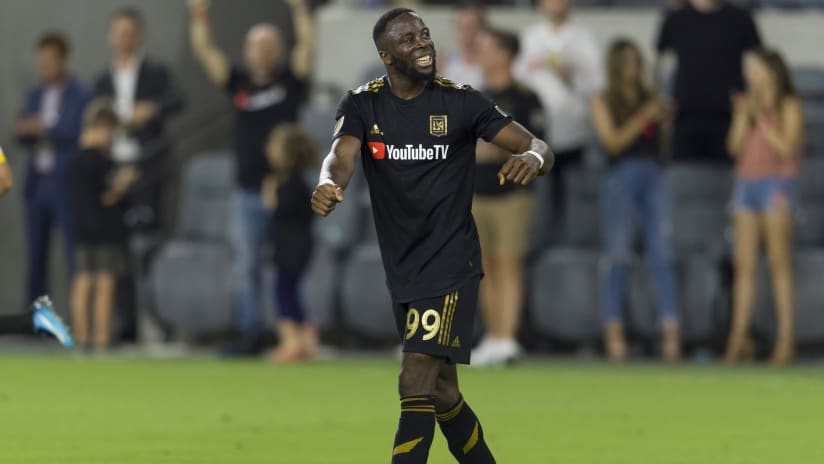Their one slip happened over a month ago, and it was an understandable one. After all, FC Dallas is now at the top of the Western Conference, and as the Portland Timbers found in their visit to Frisco, Texas, earlier this year, taking a point from Toyota Stadium can prove something to build on.
Los Angeles FC, however, didn’t need the boost. Since their mid-May visit to Providence Park – a 2-1 loss that marked an important stepping stone in the Timbers’ ascension – Major League Soccer’s newest team has taken their game to another level, something that should inspire fear in the rest of the conference given the levels LAFC were playing at, before.
When they left Portland, Bob Bradley’s team were 6-3-2 in league, an enviable record made all the more admirable by the fact that, with more talent arriving, the squad was bound to improve. In the seven games that’ve followed, LAFC has gone 4-1-2, putting up goals at a rate that’s made theirs the most productive attack in MLS.
You read that right. LAFC, not the more ballyhooed Atlanta United FC, has been the league’s standard when it comes to scoring goals. Thanks to Josef Martínez – whose 18 goals put him seven ahead of the pack in the league’s Golden Boot race – Atlanta still (and rightly) snares headlines for the potency of their approach. But their 2.1 goals per game rests slightly behind LAFC’s average, a 2.27 rate that, if maintained over the full season, would be MLS’ highest in 20 years, with only the 1998 LA Galaxy ever posting a better mark.
And remarkably, Los Angeles’ attack appears to be getting better. When the team stepped off the turf in Goose Hollow, they were averaging 1.91 goals per game, a rate that contextualizes the Timbers’ mere one goal conceded as an accomplishment. Since, LAFC is putting up 2.57 goals per contest. Seven games isn’t the biggest sample in the world, but it can’t be entirely dismissed, either. Increasing your output by 34 percent hints something new may truly be going on.
For explanations, look no farther than Adama Diomande. He’s not the northern European import via the English leagues that has captured the most attention among Los Angeles clubs, but you could make the case that he’s been the most effective, even if Zlatan Ibrahimović has set a high bar. With the rival LA Galaxy, “Ibra” has 11 goals and three assists in 14 appearances, numbers that fuel the argument MLS has an imbalance between the offensive and defensive sides of the ball. Diomande, however, has scored nine goals and collected two assists since arriving in Southern California, his seven games played (half the time of Ibra) coinciding perfectly with LAFC’s attacking surge.
It’s the type of signing that’s been emblematic of LAFC’s early success, as well as the contrast between expectations and realities around Banc of California Stadium. In the years leading up to the team’s arrival, speculation held MLS’ next marque franchise would splurge on a huge name to help open their books. To a certain extent, they did, drawing Mexican international Carlos Vela away from La Liga to run the team’s attack from day one. But Vela was no Cristiano Ronaldo. He was no David Beckham. He wasn’t even a Zlatan Ibrahimović, a player who carries a certain Jimmy Kimmel-appearing, lion-taming allure.
Instead, Los Angeles FC signed Diego Rossi, a 20-year-old Uruguayan who’s justified his Designated Player’s spot with six goals and six assists in his 16 appearances. They brought Egyptian international Omar Gaber in from Switzerland’s FC Basel (and, apparently, are ready to send him back home). 21-year-old Portuguese midfielder André Horta was signed to the team’s final DP spot. Experienced MLS defenders like Laurent Ciman (from Montreal), Walker Zimmerman (Dallas), Steven Beitashour (Toronto), and Jordan Harvey (Vancouver) immediately raised the team’s baseline, while on-the-ball veterans like Benny Feilhaber (from Sporting KC) and Lee Nguyen (New England) have augmented the team’s skill. The high-profile owners that make up LAFC’s huge ownership group were theorized to lure one or two of the game’s biggest talents to the States. Instead, they’ve taken a more measured approach.
Diomande fits right into that. Familiar to Bradley from the coach’s time in Norway while coaching Stabæk, the 28-year-old striker struggled to make an impact in three seasons with Hull City in England. His eight goals across all competitions in 64 appearances for the Tigers were a huge step down from his time in Norway, when he scored 25 times in 26 games. In just over two months in Los Angeles, the 11-time international has already eclipsed his England goal total, providing Ibra-esque production without even occupying a Designated Player spot.
If there’s a lesson to draw from LAFC’s high-flying debut, that may be it. Amid expectations that the team would take a star-studded approach to its glamorous market, the franchise has, instead, been ambitiously prudent. All of those veterans they’ve brought in aren’t cheap – good veterans never are – but the team has still been restrained. There is no Ibra, here. There’s no Steven Gerrard. There’s certainly no David Beckham. There is, instead, a desire to go out and find the next Miguel Almirón, or somebody like FC Dallas’ Ecuadorian defensive midfielder Carlos Gruezo, even if those names won’t immediately sell tickets in their market.
Instead, Los Angeles FC seems to be relying on the team to move the turnstiles. In the process – thanks to acquisitions like Diomande’s, as well as Vela’s – the team has forged the most productive attack in Major League Soccer. And when the Timbers visit Banc of California Stadium for the first time on Sunday and then play them again on Wednesday in the U.S. Open Cup (3pm PT, ESPN and 7:30pm PT, Timbers.com, respectively), they’ll find out how powerful a player like Diomande can make an already potent squad.












